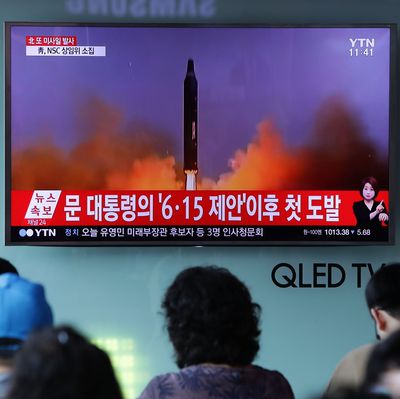
When former president Barack Obama handed the White House over to Donald Trump in January, he informed his successor that the most urgent problem he would face as president was North Korea and its accelerating nuclear weapons program. Since January, Pyongyang has conducted a series of ballistic missile tests, including one on July 4 of a missile believed to be capable of reaching Alaska. Hawaii is now taking measures to prepare for a potential nuclear air burst over Honolulu.
The latest bad news out of North Korea came on Thursday, when the Washington Post reported that U.S. and South Korean intelligence officials now believe Pyongyang will be able to produce a nuclear-capable intercontinental ballistic missile by next year, two years ahead of previous estimates.
While the North’s missile program has made significant progress, it has not yet proven that it can solve the atmospheric reentry problem (i.e., designing a missile that can withstand the upper atmosphere without damage to the warhead), but officials believe it is preparing to test a reentry vehicle as early as this week. Nor has the regime of Kim Jong-Un proven to the world that it has figured out how to miniaturize a nuclear warhead so that it can be delivered via ICBM, though it claimed to have done so last year. Nonetheless, Washington’s and Seoul’s updated assessments of the progress of the North’s nuclear program suggest Pyongyang will soon overcome this hurdle as well.
Possessing the ability to launch a nuclear strike on American cities will give the isolated Stalinist dictatorship an intolerable amount of leverage in extorting concessions from the international community and dash any hopes of forcing the regime out of power. That’s why its government enjoys threatening, as it did again on Thursday, to “strike a merciless blow at the heart of the U.S. with our powerful nuclear hammer” if the U.S. dares make any attempt at regime change in Pyongyang. Seoul and Tokyo are more likely targets for an actual strike than Honolulu or Los Angeles, but as always in nuclear politics, it’s the threat that counts.
More alarming still, a North Korea with the ability to field nuclear-tipped ICBMs will raise the stakes of regional geopolitics and diplomacy in North Asia by orders of magnitude, especially given the Kim regime’s paranoia and habit of lashing out at perceived threats. Needless to say, this is not an ideal moment for the U.S. to have a president prone to mouthing off, making cryptic and contradictory public statements, issuing idle threats, and shaking down our allies (including South Korea) for protection money — yet here we are.
Another factor in this crisis is Russia, which has its own complicated relationship with the Trump administration. Russian exports to North Korea doubled in the first five months of 2017, CNBC reports, suggesting that Moscow is ramping up its economic support for its Soviet-era client. Russia also blocked U.S. efforts to have the United Nations Security Council condemn Pyongyang’s missile test earlier this month, and is resisting the imposition of additional U.N. sanctions. Russia could be trying to use North Korea as a pawn to pressure the U.S. on issues like Syria and Ukraine. Add North Korean ICBMs to the board, and that pawn becomes a queen.
Then there’s China: North Korea’s main investor, trade partner, and economic lifeline. Beijing has been pushing a proposal that would see Pyongyang freeze its nuclear program in exchange for a halt to large-scale joint military exercises between the U.S. and South Korea (both developments that would suit its interests nicely). The North Koreans are apparently receptive to this “dual freeze” arrangement, but the U.S. and South Korea are not.
So how should the Trump administration handle this crisis? As Mark Bowden explained in his recent Atlantic cover story, all of Washington’s military options for bursting Kim’s nuclear ambitions would have catastrophic risks and no guarantee of fulfilling their objectives. Some voices on the right are urging the U.S. to increase pressure on China to contain its troublesome ally, whether through sanctions, an Asian counterpart to NATO, or a missile-defense arms race. Others say the best path forward is to open good-faith negotiations with Pyongyang, as South Korea’s new president Moon Jae-in has expressed interest in doing.
What the administration will do is another question entirely. An embattled White House, an intelligence Establishment disdained by the president, and a systematically depopulated State Department are not the best partners to devise a coherent strategy for facing down the North Korean threat.





























